Asymptotic Hyperstability of a Class of Linear Systems under Impulsive Controls Subject to an Integral Popovian Constraint
Abstract
This paper is focused on the study of the important property of the asymptotic hyperstability of a class of continuous-time dynamic systems. The presence of a parallel connection of a strictly stable subsystem to an asymptotically hyperstable one in the feed-forward loop is allowed while it has also admitted the generation of a finite or infinite number of impulsive control actions which can be combined with a general form of nonimpulsive controls. The asymptotic hyperstability property is guaranteed under a set of sufficiency-type conditions for the impulsive controls.
1. Introduction
The problems of absolute stability and hyperstability classically received much attention from the fifties in a wide class of problems of control theory and its applications, [1–10]. Some extensions or applications of hyperstability theory rely on the incorporation of the formalism of quantified controls [3] and multiple nonlinearities, [4]. Also, in some of the studies, the incorporation of extra subsystems to the linear positive real part, the presence of delays, and that of hybrid continuous-discrete systems has also been considered, [5–7]. Its extension to some models based on neural networks has been studied in [9] and references therein, while its usefulness for the design of adaptive schemes with good stability and transient properties was proposed in a set of results compiled in [10] and in more exhaustive later investigations performed along the eighties and nineties. The properties of parametrical stability of nonlinear systems with some robustness extensions have been investigated in [11, 12] and references therein. Also, applications of stability theory to base-isolated building structures including modelling delays and wireless control issues has been investigated in a number of papers. The main objective of the studies is to prevent the structures via active control designs against earthquake or heavy wind potential damages. See, for instance, [13, 14] and references therein. In those studies, Lyapunov stability and associated appropriate manipulations via linear matrix inequalities are used ad hoc for the problems at hand.
Furthermore, the following Figures 3 and 4 show, respectively, the output and control input to the system.
The problem of absolute stability is basically stated as that of guaranteeing the global asymptotic stability of a control system consisting of a linear plant under a feedback nonlinear regulator which belongs to a certain class of regulators all satisfying either some sector-type or some integral-type constraints of Lurie’s or Popov’s type, respectively. See, for instance, [2–4, 15–17]. If global asymptotic stability is guaranteed for the whole class of regulators then it is typically said that the closed-loop system is absolutely stable for such a class of controllers. The main reason for setting this theory was its ability to guarantee the stabilization for a whole class of systems under potential dispersion of the values of the parameters in a serial controller construction process while keeping its stabilization capability. Thus, it is a robustly stable design for a characterization of the nonlinear feedback controller as belonging to a certain admissible class. Then, the absolute stability property is guaranteed for the feed-forward controlled object and the whole class of nonlinear controllers.
The more general problem of asymptotic hyperstability extends that of absolute stability to classes of nonlinear regulators satisfying integral-type constraints for eventually time-varying nonlinearities which are not necessarily constrained to sectors. The asymptotic hyperstability property of a closed-loop system requires, in particular, that the feed-forward loop consists of a positive real transfer matrix (sometimes referred to as the asymptotic hyperstability of the linear feed-forward loop) or function, and that the nonlinear/time-varying controller belongs to a class satisfying an integral-type constraint, the so-called Popovian integral inequality, [15, 16]. Then, the property is guaranteed for such a linear feed-forward linear block and the whole class of nonlinear/time-varying controllers. Historically, the properties of absolute stability and hyperstability were of crucial interest by the time of World War II because the component dispersion in regulators controlling tanks often fail the blank targeting process, [16]. Such a practical problem motivated the convenience of formulating and designing stabilizing classes of regulators rather than individual stabilizing ones, [15, 16]. The related studies on this subject have been performed for the stabilization of both linear continuous-time and discrete dynamic systems.
Asymptotic hyperstability has also received a very important attention in adaptive control designs such as model reference adaptive control or model reference adaptive systems. See, for instance, [17–25] and references therein. A wide representation of practical problems has been focused on this theoretical formalism including theoretical design of adaptive systems, adaptive control of manipulators and other robotic devices, adaptive neural networks, and synchronization. A main reason of the success of the hyperstability formal theory in the existing background of adaptive designs relies on the fact that the implementation of the estimation algorithms is flexible while offering the designer the chance of choosing wide ranges of admissible values of the free design parameters being compatible with accomplishing the required properties of convergence and closed-loop stabilization.
Most of the stability problems can be extended to the use of switching laws acting on the controlled objects or on their controllers so that the dynamics can be changed to improve certain suitable performances like, for instance, suited settling times or transient errors, or to accommodate the system behavior to suitable transients around several operation points. This frequently happens in complex dynamic problems associated to distinct phases in some production chains like it occurs, for instance, in some chemical engineering processes. Some of such complex models might include point or distributed delays and/or hybrid structures consisting of continuous-time, discrete-time, and digitally modelled subsystems. The existing background literature on switching dynamics is exhaustive. See, for instance, [26–29] and references therein. Finally, recent work on absolute stability and hyperstability of complex nonlinear models, including absolute stability of hyperbolic systems and topics related to Ulam’s-type stability, has been reported in [30–32] and some of the references therein.
Other topics of increasing interest in the last years and nowadays in stabilization and control of dynamic systems are that of the synthesis of impulsive controls and that of the switching conditions of the dynamics guaranteeing the closed-loop stabilization. In particular, the injection of impulsive controls lead to a discontinuous sudden change (in practice, in a very short time interval) in the state vector at impulsive time instants. Switched dynamic systems have several possible parameterizations while switches among them in such a way that the dynamic system is parameterized by one of such parameterizations in connected time-intervals before the next switching happens. It is of interest the design of switching laws which ensure closed-loop stabilization either conditionally, via appropriate rules either on the minimum residence time or on the averaging dwelling times, or under arbitrary switching. Exhaustive work has been made in this field. See, for instance, [26–30, 33–39] and references therein. Related studies are of interest, for instance, in synchronization, deterministic, and stochastic stabilization, impulsive vaccination in epidemic models, control of chemical process under their various dynamics, and so forth. Switched dynamic systems and impulsive control also appear in some combined problems. See, for instance, [27, 38–40] and references therein.
- (a)
it has admitted the presence of a parallel connection of a linear strictly proper and strictly stable subsystem to the standard linear asymptotically hyperstable subsystem in the feed-forward loop of the feedback system;
- (b)
the generation of a finite or infinite number of impulsive control actions is allowed while it can be combined with a general form of nonimpulsive controls. The control impulses can be state/output dependent or not.
2. Problem Statement and Some Preliminary Results
- (i)
is both strictly stable and strictly proper with poles in Re s ≤ −σ < 0 for some σ ∈ R+ and satisfying for some nonnegative real constant and all ω ∈ R0+. Note that its real part is finitely lower-bounded since it is strictly stable.
- (ii)
G*(s) is strictly positive real with d* = d0 = lim ω→±∞G(iω) = lim ω→±∞G*(iω) > 0, since, whereis the complex unit andis strictly proper and strictly stable since G*(s) is strictly positive real and d0 is a positive real constant.
- (i)
if τ ∈ [t1, t2) and, otherwise, it is a truncated function of f(t) (f0,t(τ) ≡ ft(τ) is used for notation abbreviation);
- (ii)
Im (t) = {t1, t2, …, tp(t)} is the set of impulsive time instants until time t with the convention tp(t) < t so that Im (t+) = {t1, t2, …, tp+1(t) = t} if t, itself, is an impulsive time instant which is denoted by t ∈ Im (t+). Note that the convention implies that if t ∉ Im (t+) then Im (t+) = Im (t) and that tk ∉ Im (tk). Let us also denoteas the whole set of impulsive time instants and card Im∞ is its cardinal. The notation card Im∞ = χ0 (the usual symbol for an infinite cardinal of a numerable set) refers to the case when the set of impulses is infinity while card Im∞ < χ0 indicates that there is a finite number of impulses.
The limit notationused in some of the obtained results stands for the limits as time tends to infinity within the interimpulse time intervals provided that they exist. In this context, note that (6) is very general so that the impulses can be state-dependent or not. Thus, such limits do not always exist as time tends to infinity to the left of the impulsive time instants. This motivate the use of such a notation.
The following definitions are well-known from the background literature for the impulsive-free case uim(t) = u(t) in (6).
Definition 1. The closed-loop system (1)–(4) is said to be asymptotically hyperstable (resp., hyperstable) for the impulsive-free case uim(t) = u(t) for all t ∈ R0+ if it is globally asymptotically stable (resp., globally stable) for any control device satisfying Popov’s integral inequalityand any nonzero γ ∈ R+.
The following preliminary technical results to be then used to establish the main asymptotic hyperstability results hold.
Lemma 2. The input-output energy measure on the time intervals [0, t), respectively, on , respectively, on [0, t] is uniformly bounded for all time while it satisfies the following relationships:
Proof. See Appendix A.
A useful result based on Lemma 2 follows below so as to get the main stability result after establishing the subsequent definition.
Definition 3. Any sequence of impulsive gains {Kj} subject to the following constraints:
The feature that if (4) holds for any nonzero γ then it also holds for any γ′ ≥ γ makes that the particular value of any finite nonzero γ in (10) can be increased to upper-bound the admissible impulsive gains for different controls while keeping the validity of the formulated asymptotic hyperstability theorem for the impulsive case. See Theorem 10 in Section 3.
Definition 4. An integral Popovian inequality (4) for a nonzero real constant γ and an impulsive control is said to be impulsive control-compatible if the sequence of impulsive gains {Kj} is of the class Igain(Im∞, γ, g) for some γ ∈ R+.
Lemma 5. Assume that the sequence of impulsive gains for system (1)–(4) is of the class Igain = Igain(Im∞, γ, g), then, the following properties hold:
Proof. See Appendix B.
Lemma 5 is subject to the subsequent important necessary condition.
Lemma 7. Assume thatthen a necessary condition for Lemma 5 to hold is that the class Igain = Igain(Im∞, γ, g ) is such that t1 = 0 ∈ Im(t) ⊂ Im∞ for all t ∈ R0+, and its associate impulsive gain satisfies the constraint:
Proof. Proceed by contradiction by assuming that , Im∞∋t1 > 0, and Lemma 5 holds so that (12) holds. Then,
To the light of Definition 3, the hyperstability concepts of Definition 1 are extended so as to consider also certain classes on impulsive controls which lead to the global asymptotic stability of the closed-loop system as follows.
Definition 8. The impulsive closed-loop system (1)–(4) is said to be impulsive asymptotically Igain(Im∞, γ, g)-hyperstable (resp., impulsive Igain(Im∞, γ, g)-hyperstable) if it is globally asymptotically stable (resp., globally stable) for any sequence of impulsive gains {Kj} of the class Igain = Igain(Im∞, γ, g) for a given nonzero γ ∈ R+, a given support sequence {g(tj)}, tj ∈ Im∞, and any control device satisfying an impulsive control compatible Popov’s integral inequality.
3. Main Results on Asymptotic Hyperstability
It turns out that Lemma 7 establishes that the origin has to be an impulsive time instant to keep the input-output energy to be positive and upper-bounded for all time. On the other hand, Lemma 5 leads to the subsequent main result of usefulness in the impulsive-free case.
Theorem 9. Assume that Im∞ = ∅ (i.e., there are no impulsive controls). Then, the following properties hold.
- (i)
Assume also that G*(s) ∈ SPR and. Then, ∞ > E(t) ≥ 0 for all t ∈ R0+ with E(0) = 0, and the closed-loop system is asymptotically hyperstable for any nonlinear feedback device φ(y(t), t) satisfying Popov’s integral inequality for all t ∈ R0+. As a result, G(s) ∈ SPR, lim t→∞u(t) = 0, u(t), y(t) and x(t) are uniformly bounded for all t ∈ R0+, and lim t→∞y(t) = 0 and lim t→∞x(t) = 0 for all x0 ∈ Rn.
- (ii)
Assume that Re G*(iω) > 0, for all ω ∈ R0+, and.
Proof. It is given in Appendix C.
Theorem 9(i) addresses the asymptotic hyperstability for the impulsive-free case when G*(s) ∈ SPR is strongly positive real since G*(iω) ≥ d > 0 for all ω ∈ R0+. Theorem 9(ii) considers the same property for the case when G*(s) ∈ SPR is weakly positive real since G*(iω) > 0 and d = lim ω→±∞G*(iω) = 0, that is, the transfer function is strictly proper so that it is zero at infinity frequency. Lemma 5 leads to the subsequent main result of usefulness in the control impulsive case.
Theorem 10. Assume that card Im∞ ≤ χ0 (i.e., there are impulsive controls with χ0 being the infinity cardinal of a denumerable set) for any set of control impulses of amplitudes satisfying (10). Then, the following properties hold.
- (i)
Assume also that G(s) ∈ SPR with . Then, ∞ > E(t) ≥ 0 for all t ∈ R0+ with E(0) = 0, and the closed-loop system is impulsive asymptotically Igain(Im∞, γ, g)-hyperstable for any nonlinear feedback device φ(y(t), t) satisfying a compatible Popov’s integral inequality for all t ∈ R0+. As a result, y(t) and x(t) are uniformly bounded for all t ∈ R0+ for all x0 ∈ Rn, u(t) is bounded for t ∈ R0+∖Im∞, with if card Im∞ = χ0 (i.e., there are infinitely many control impulsive time instants); and lim t→∞u(t) = 0 if card Im∞ < χ0, that is, if there is a finite number of control impulsive time instants. Also
() - (ii)
Assume that Re G*(iω) > 0, for all ω ∈ R0+ and.
Proof. It is given in Appendix D.
Note that the constraint (10) invoked in Theorem 10 is guaranteed by amplitude constraints of each impulse at tk depending only on input and output values on [0, tk) for the case of signal-dependent control impulses.
4. Some Extensions Concerning Robustness
Definition 11. Any sequence of impulsive gains {Kj} subject to the following constraints:
Definition 12. The impulsive closed-loop system (17), subject to (2), is said to be robustly impulsive asymptotically Irgain(Im∞, γ, g, η, λ)-hyperstable (resp., impulsive Irgain(Im∞, γ, g, η, λ)-hyperstable) if it is globally asymptotically stable (resp., globally stable) for any sequence of impulsive gains {Kj} of the class Irgain(Im∞, γ, g, η, λ) for a given nonzero γ ∈ R+, a given support sequence {g(tj)}, tj ∈ Im∞ and any control device satisfying an impulsive control compatible Popov integral inequality; for all t ∈ R0+.
Now, the asymptotic hyperstability Theorem 10 is directly extended for robust asymptotic hyperstability as follows.
Theorem 13. Assume that card Im∞ ≤ χ0 for any set of control impulses of amplitudes satisfying (20). Assume also thatis uniformly bounded for all t ∈ R0+ (it suffices that λ(t) and η(t) be bounded for all time). Then, the following properties hold.
- (i)
Assume also that G(s) ∈ SPR with . Then, ∞ > E(t) ≥ 0 for all t ∈ R0+ with E (0) = 0, and the closed-loop system is robustly impulsive asymptotically Irgain(Im∞, γ, g, η, λ)-hyperstable for any nonlinear feedback device φ(y(t), t) satisfying a compatible Popov’s integral inequality for all t ∈ R0+. As a result, y(t) and x(t) are uniformly bounded for all t ∈ R0+ for all x0 ∈ Rn, u(t) is bounded for t ∈ R0+∖Im∞, with if card Im∞ = χ0 (i.e., there are infinitely many control impulsive time instants); and lim t→∞u(t) = 0 if card Im∞ < χ0 (i.e., there is a finite number of control impulsive time instants).
- (ii)
Assume that Re G*(iω) > 0, for all ω ∈ R0+ and.
Then, Lemma 5 holds and the closed-loop system is robustly asymptotically hyperstable for any nonlinear feedback device φ(y(t), t) satisfying Popov’s integral inequality for all t ∈ R0+. Then, y(t) and x(t) are uniformly bounded for all t ∈ R0+, for all x0 ∈ Rn, u(t) is bounded for t ∈ R0+∖Im∞, with if card Im∞ = χ0 (i.e., there are infinitely many control impulsive time instants); and lim t→∞u(t) = 0, lim t→∞x(t) = 0 and lim t→∞y(t) = 0 if card Im∞ < χ0 (i.e., there is a finite number of control impulsive time instants) or if card Im∞ = χ0 (i.e., there are infinitely many control impulsive time instants) and Kj → 0 as j → ∞.
Proof (outline). It is given in Appendix E.
5. Numerical Examples
5.1. Asymptotic Hyperstability in the Impulsive-Free Case
Figures 1 and 2 show the evolution of the state variables of the SPR system G*(s) when members of the family of nonlinear static feedback devices φi(y, t) = tanh (γiy) are used as controllers.
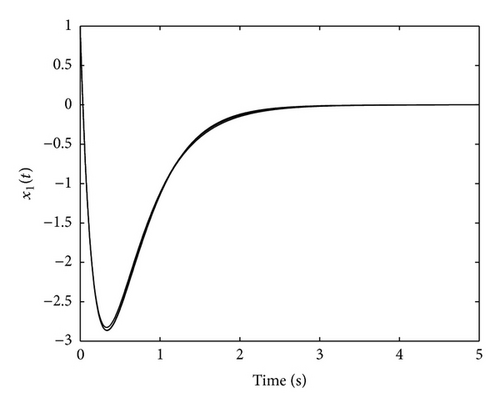
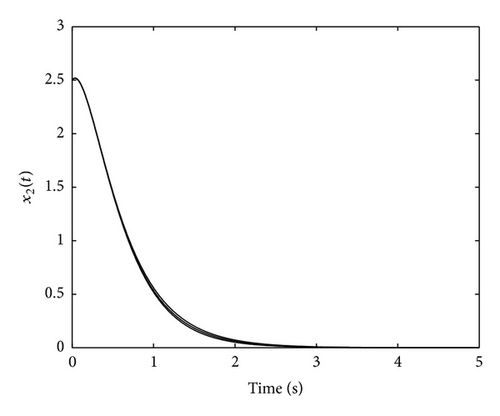
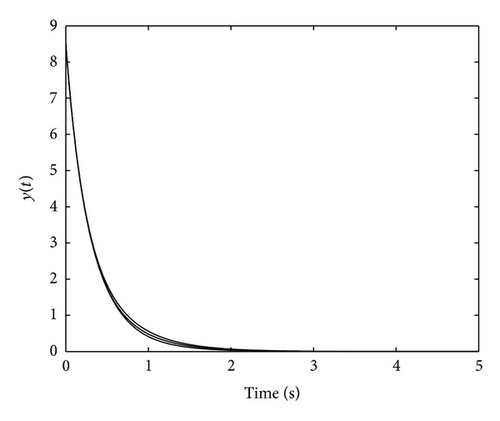
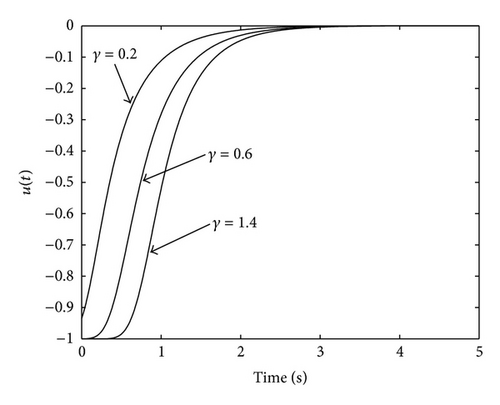
Figures 1–4 confirm the results of Theorem 9(i) guaranteeing the boundedness and convergence to zero of the state, the output and the control signal. Moreover, it can be appreciated in Figures 1–3 that the evolution of the system is very similar for the different considered values of γi. This similar evolution is obtained at the expense of a different control action for each γi, as Figure 4 depicts. On the other hand, the following Figures 5, 6, and 7 show the state evolution, the output and the control input for the non-SPR system G(s). The particular value of γi = 0.6 has been used in Figures 5 and 6 since the evolution of the system is very similar for all values of γi. However, Figure 7 shows the control input for different values of γi since its value varies depending on γi. Figures 5–7 confirm the results of Theorem 9(ii) guaranteeing the convergence to zero of the state, the output, and the control signal. The next Section 5.2 is devoted to the study of the impulsive control.
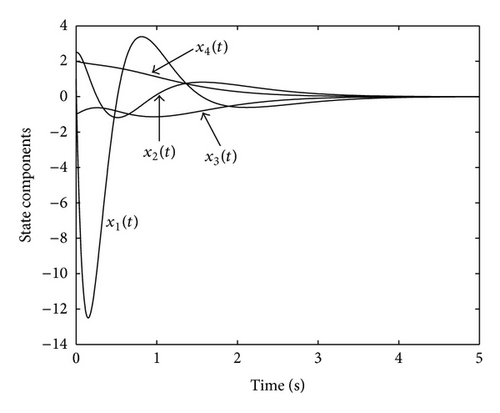
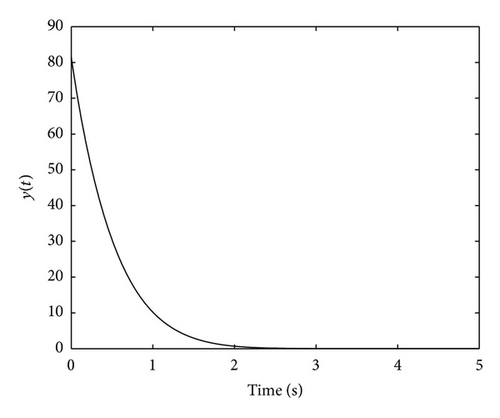
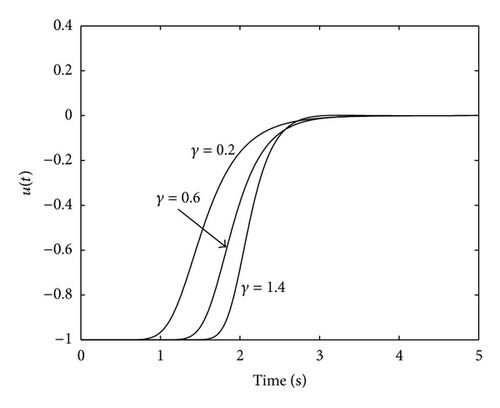
5.2. Asymptotic Hyperstability in the Presence of Impulses
A number of impulses are added to the nonlinear feedback controller introduced in Section 5.1. The support sequence is given by g(tk) = y(tk) and the impulsive gains constant Kk = 1. The impulsive time instants are multiples of 0.2 seconds; this means that the presence of impulses is periodic. The value γi = 0.6 has been used for the sake of simplicity. Figure 8 depicts the evolution of the state variables of the SPR transfer function G*(s) while Figure 9 shows the output. Finally, Figure 10 illustrates the control input with the impulsive action.
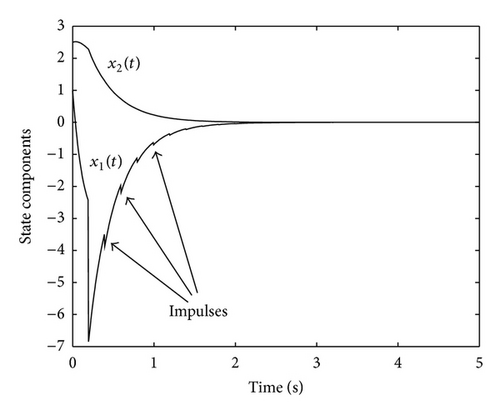
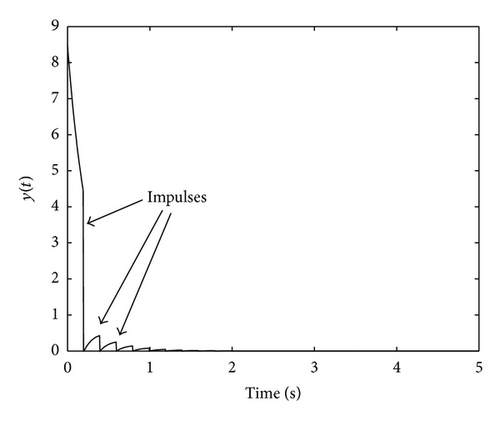
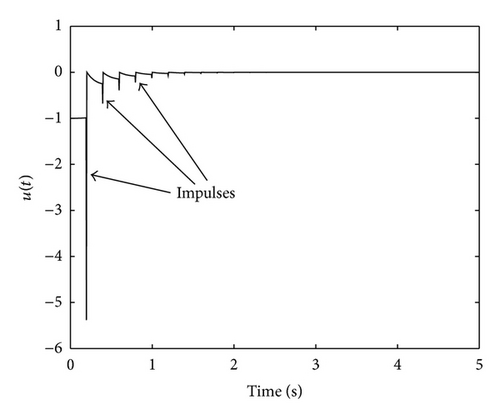
Figures 8–10 confirm the statements of Theorem 10(i) showing the convergence to zero of the state, the output, and the control signal. In addition, these figures explicitly show the presence of impulses in different signals of the system. On the other hand, for the complete system, G(s), we obtain the following Figures 11, 12, 13, and 14 depicting the state evolution, the output, and the control input.
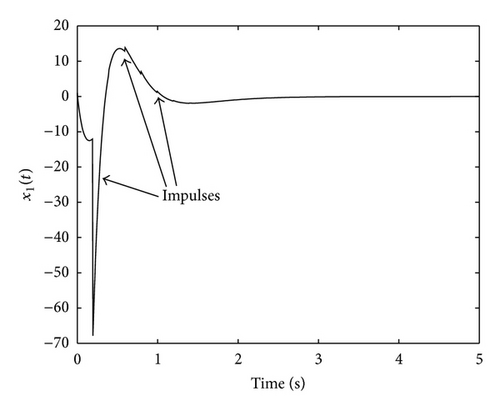
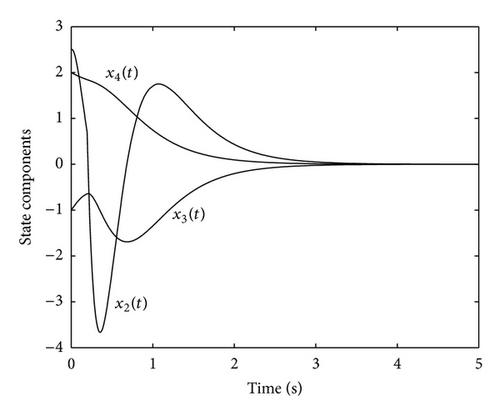
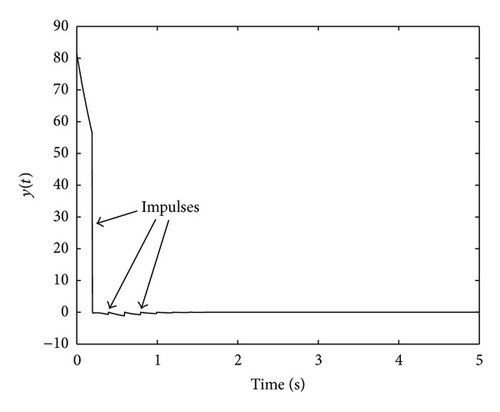
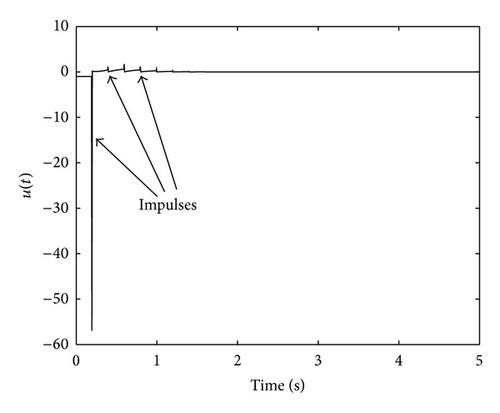
Figures 11–14 illustrate the results compiled in Theorem 10(ii) since they show the convergence of the state, the output and the input to zero. Moreover, it can be appreciated the effect of adding impulses to the control signal by first comparing Figures 3 and 9 and, on the other hand, Figures 6 and 13. It can be deduced that the use of an impulsive controller makes the output to converge to zero faster than when a single continuous-time one is used. This fact highlights how the concept of impulsive asymptotic hyperstability is relevant since it allows ensuring the closed-loop stability for a whole family of nonlinear devices while accelerating the convergence of the output to zero.
6. Conclusions
This paper has studied the problem of asymptotic hyperstability under a regular controller combined with a class of impulsive controls provided that the feed-forward linear- loop is not asymptotically hyperstable, since it has a parallel component subsystem being strictly stable. Asymptotic hyperstability results with robustness extensions have also been discussed. The controller has been assumed to satisfy an integral Popovian-type inequality for all time. Also, examples have been given to illustrate the proposed study.
Acknowledgments
The authors are grateful to the Spanish Government for its support of this research through Grant DPI2012-30651 and to the Basque Government for its support of this research through Grants IT378-10 and SAIOTEK S-PE12UN015. They are also grateful to the University of Basque Country for its financial support through Grant UFI 2011/07. Finally, the authors are very grateful to the reviewers by their useful comments.
Appendices
A. Proof of Lemma 2
and the proof is complete.
B. Proof of Lemma 5
C. Proof of Theorem 9
- (1)
,
- (2)
.




